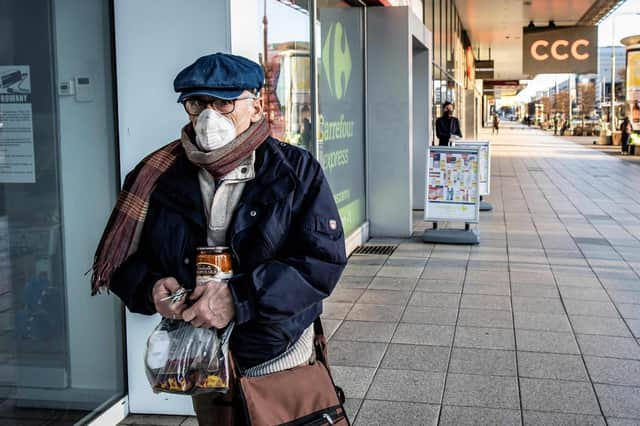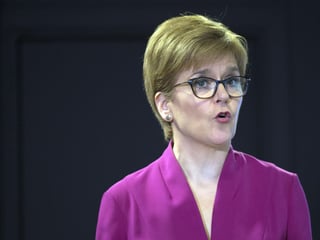Coronavirus falsehoods pose grave threat to elderly – Martyn McLaughlin


Our ability to take the necessary steps to ensuring the welfare of a demographic most at risk from the coronavirus pandemic was already being questioned before the outbreak. Such concerns were sincere and well-founded, but the events of the past 72 hours have laid waste to perceptions of the country’s social crisis.
The steepest challenge in this daunting new reality will be how to look after a subset of the population nearly three-quarters of a million strong.
Advertisement
Hide AdAdvertisement
Hide AdThose pressures will be felt most acutely by those exhausted personal care staff who tend to nearly 50,000 Scots in their own home.
Families and entire communities will have to step in and play their part. In time, hopefully all of us will gleam a better appreciation of the importance of a profession with mounting workloads and miserly rates of pay.
Beyond such practical care, however, the prospect of this group entering into several months of self-isolation presents its own difficulties.
In light of the fast-moving scientific research, a measure that seemed draconian only a week or so ago now seems not just eminently reasonable, but essential.
There is, however, an incalculable price to be paid in terms of the mental health impact, and with people turning to social media to maintain contact with the outside world, a perfect storm lies in wait.
In the past few days, I have noticed several older friends and acquaintances posting what could charitably be described as nonsense relating to coronavirus. They include a seasoned university lecturer, a retired family lawyer, and a writer. All are intelligent, rational people. Unfortunately, they have yet to develop an immunity to the scourge of disinformation.
Even if you consider yourself a digitally literate citizen, you need not look far to find falsehoods about the virus, its symptoms, and how best to avoid infections.
The posts which have achieved the greatest prominence are those which hint at a kernel of truth. Take, for example, a slew of graphics featuring Unicef branding which insisted that face masks prevent transmission of the virus. The posts, and variations of it, continue to circulate on Facebook, WhatsApp, and Twitter, despite being denounced by the charity.
Advertisement
Hide AdAdvertisement
Hide AdOther varieties are blunter instruments, simultaneously willfully false and malicious. Unsurprisingly, Infowars – a prominent spreader of swivel-eyed conspiracy theories – has played its part in this regard, having claimed the outbreak was predicted last October by the Bill and Melinda Gates Foundation
Some strains of the falsehood pandemic, meanwhile, posit patently absurd theories, but are given oxygen by virtue of the fact they emanate from supposedly reliable sources.
Allison Pearson, the Daily Telegraph columnist, stated on Twitter that the virus “doesn’t infect children”. This is a demonstrably false claim. Not only do children have no immunity, but the fact they generally present milder symptoms than adults means there is a heightened risk of them passing it on to older, more vulnerable family members.
One harmful irony in all this is that it is elderly people who are the most likely to trust such feckless comments and pass it on to their peers.
The majority of these stories – intentionally or systematically factually inaccurate – were focused on politics, with people regarding social endorsements, such as posts shared by their friends, as a badge of credibility and, ultimately, truth.
There has been a long and ongoing debate over how that trend has disrupted our political discourse and helped give rise to populist governments. But at this particular time, the threat it poses is altogether more urgent.
Even when it is done with the best of intentions, people may be endangering loved ones simply by sharing in good faith information they hope will protect them.
There will be grandparents out there who have read – or heard about – Ms Pearson’s comments, and as a result, believe they face no risk in looking after their grandchildren.
Advertisement
Hide AdAdvertisement
Hide AdThat is inexcusable, though not quite so appalling as the fact that Ms Pearson’s tweet – posted on 2 March – is still available for her 54,000 followers, or anyone else for that matter, to see.
It has been reassuring to see acknowledgement of this disinformation threat. Stewart McDonald, the SNP MP for Glasgow South, has written to the chief executives of Facebook, Twitter, and Alphabet, Google’s parent firm, to emphasise the “critical” importance of social media platforms ensuring people can have access to a flow of official public health guidance at a time when many are entering self-isolation.
It is vital, he said, that such platforms are “not weaponised to spread false information which could endanger lives or cause unnecessary panic and alarm”.
There is no justification for these companies to pursue the well-worn course of inaction they have tread in the past when confronted with their role in propagating disinformation. This time around, lives are at stake, and systemic change is required, not minor concessions.
We must remember that the goal of disinformation is not simply to ensure falsehoods and fallacious arguments prosper. They are merely means to an end.
The ultimate aim is to provoke emotional reactions, exploit anxieties, and sow unrest and mistrust. Many people facing up to the prospect of being home alone for months on end will already be experiencing such feelings. It is incumbent on all of us to ensure that they are not just cared for, but protected from exploitation.
